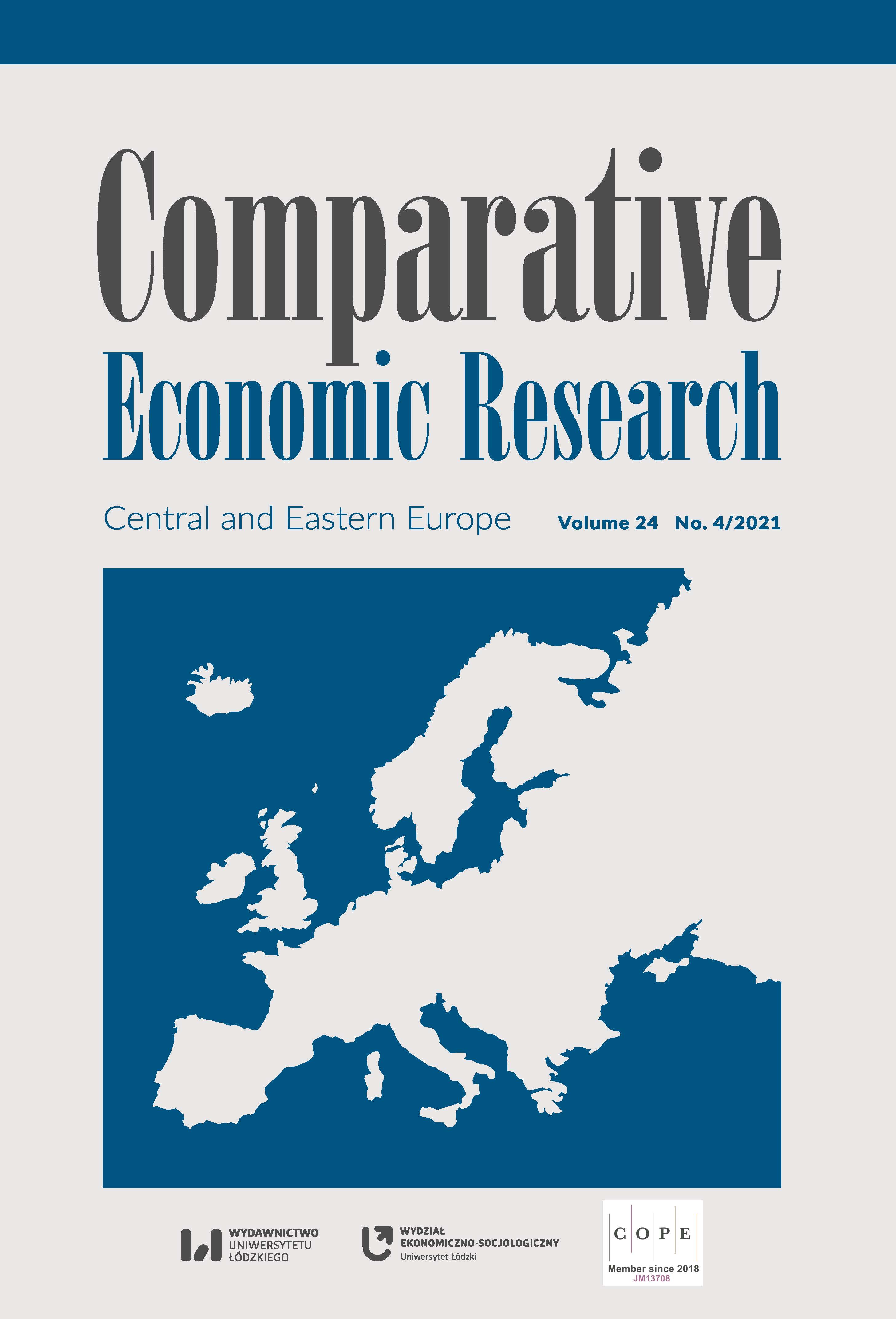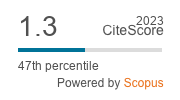Economic Development and Growth in Central and Eastern Europe
DOI:
https://doi.org/10.18778/1508-2008.24.31Keywords:
economic indicators, labour market processes, economic growthAbstract
The study investigates the economic growth in Central and Eastern Europe in the last 25 years. The economy can be regarded as a substantial topic in any country, but it is even more interesting in developing countries. One of the basic ideas of the European Union is the convergence between member states, namely the reduction of development disparities, which can be achieved through faster economic growth in less‑developed countries. Growth theory is one of the main topics in economics. Its significant importance is because the desire for development is one of the main driving forces of mankind. The aim of the study is to reveal the crucial differences and common features between the growth paths of the eleven Central and Eastern European member states of the European Union. After presenting growth theories, the growth performance of the examined Central and Eastern European member states is pinpointed. During the research, GDP per capita, population, migration, activity rate, employment rate, unemployment rate, foreign direct investment and foreign trade openness are considered.
Downloads
References
Acemoglu, D. (2016), Introduction to Modern Economic progress, Department of Economics, Massachusetts Institute of Technology, Cambridge, https://www.theigc.org/wp-content/uploads/2016/06/acemoglu-2007.pdf (accessed: 9.08.2020).
Google Scholar
Alotaibi, A.R., Mishra, A.V. (2014), Emerging Markets and the Global Economy, [in:] M. Arouri, S. Boubaker, D. Nguyen (eds.), Emerging Markets and the Global Economy, Academic Press, Oxford, Emerging Markets and the Global Economy, Oxford, pp. 749–771, https://www.sciencedirect.com/science/article/pii/B9780124115491000314 (accessed: 9.08.2020).
Google Scholar
DOI: https://doi.org/10.1016/B978-0-12-411549-1.00031-4
Barna, K., Molnár, T. (2019), Veszprém megye településeinek társadalmi és gazdasági fejlettsége [Social and Economic Development of Settlements of Veszprém County], “Deturope”, 11 (2), pp. 169–184, http://www.deturope.eu/index.php?navi=101&vol=42 (accessed: 9.08.2020).
Google Scholar
DOI: https://doi.org/10.32725/det.2019.021
Bathelt, H., Buchholz, M. (2019), Outward Foreign Direct Investments as a Catalyst of Urban-Regional Income Development? Evidence from the United States, “Economic Geography”, 95 (5), pp. 442–466, https://www.tandfonline.com/doi/pdf/10.1080/00130095.2019.1665465?needAccess=true (accessed: 12.08.2020).
Google Scholar
DOI: https://doi.org/10.1080/00130095.2019.1665465
Bertalan, P., Sarudi, Cs. (2016), A globalizáció és a kohéziós politika hatása Magyarországon a 2014–2020-as időszakban [Globalisation and the Effect of the Cohesion Policy in Hungary in 2014–2020], “Deturope”, 8 (2), pp. 73–87, http://www.deturope.eu/index.php?navi=101&vol=23 (accessed: 9.08.2020).
Google Scholar
DOI: https://doi.org/10.32725/det.2016.016
Bláha, D., Labem, U., Nováček, A., Budějovice, C. (2016), How Central Europe is Perceived and Delimited, “Mitteilungen der Österreichischen Geographischen Gesellschaft”, 158, pp. 193–214, http://austriaca.at/0xc1aa5576%200x003aad6f.pdf (accessed: 31.08.2020).
Google Scholar
DOI: https://doi.org/10.1553/moegg158s193
Czárl, A. (2005), Szerkezeti átalakulás, gazdasági növekedés meghatározó tényezői és hatásai az agrárágazatban Magyarországon [Determinants and effects of structural change and economic progress in the agricultural sector in Hungary], Szent István Egyetem, Gazdálkodási- és Szervezéstudományok Doktori Iskola, Doktori (PhD.) értekezés, Gödöllő, http://archivum.szie.hu/JaDoX_Portlets/documents/document_3156_section_3299.pdf (accessed: 9.08.2020).
Google Scholar
Eichenauer, P., Klee, A. (2013), Regionalentwicklung, Migration und Fläche, “Raumforschung und Raumordnung. Spatial Research and Planning”, 71 (6), pp. 453–454, https://doi.org/10.1007/s13147-013-0260-9
Google Scholar
DOI: https://doi.org/10.1007/s13147-013-0260-9
Eurostat, Population by sex, age, country of birth and labour status (1 000), https://ec.europa.eu/eurostat/web/products-datasets/-/lfsq_pgacws (accessed: 31.08.2020).
Google Scholar
Eurostat, Purchasing power adjusted GDP per capita, https://ec.europa.eu/eurostat/web/products-datasets/-/sdg_10_10 (accessed: 31.08.2020).
Google Scholar
Gudowski, J., Piasecki, R. (2020), Foreign Direct Investment from Emerging Markets. Theory and Practice, “Comparative Economic Research. Central and Eastern Europe”, 23 (2), pp. 7–19, http://doi.org/10.18778/1508-2008.23.09
Google Scholar
DOI: https://doi.org/10.18778/1508-2008.23.09
Kilper, H., Klee, A. (2018), Über soziale Verwundbarkeit, Planungsmethoden und Arbeitskräftemobilität, “Raumforschung und Raumordnung. Spatial Research and Planning”, 76 (6), pp. 483–484, https://doi.org/10.1007/s13147-018-0561-0
Google Scholar
DOI: https://doi.org/10.1007/s13147-018-0561-0
Korcelli, P., Korcelli-Olejniczak, E. (2015), Metropolitan Transition in East-Central Europe, “Mitteilungen der Österreichischen Geographischen Gesellschaft”, 157, pp. 29–49, http://austriaca.at/0xc1aa5576%200x0032bbaf.pdf (accessed: 31.08.2020).
Google Scholar
DOI: https://doi.org/10.1553/moegg157s29
Krajewska, A., Krajewski, S. (2020), The Labor Market in Poland and the Social Responsibility of the State and Business: Comparative Aspects, “Comparative Economic Research. Central and Eastern Europe”, 23 (1), pp. 93–109, https://doi.org/10.18778/1508-2008.23.06
Google Scholar
DOI: https://doi.org/10.18778/1508-2008.23.06
Lengyel, I., Varga, A. (2018), A magyar gazdasági növekedés térbeli korlátai, helyzetkép és alapvető dilemmák [Spatial constraints, situation and basic dilemmas of Hungarian economic growth], “Közgazdasági Szemle”, LXV, pp. 499–524, http://real.mtak.hu/79542/1/03_Lengyel_VargaA_u.pdf (accessed: 9.08.2020).
Google Scholar
DOI: https://doi.org/10.18414/KSZ.2018.5.499
Manić, E., Popović, S., Mitrović, D. (2016), Is there a “Chinese Wall” in Europe? A Glance at the Development of Socio-economic Disparities in Europe, Räumliche Disparitäten Spatial Disparities, “Mitteilungen der Österreichischen Geographischen Gesellschaft”, 158, pp. 133–148, http://austriaca.at/0xc1aa5576%200x003aad69.pdf (accessed: 31.08.2020).
Google Scholar
DOI: https://doi.org/10.1553/moegg158s133
Mankiw, N.G., Romer, D., Weil, D.N. (1992), A contribution to the empirics of economic growth, “The Quarterly Journal of Economics”, May, pp. 407–437, https://eml.berkeley.edu/~dromer/papers/MRW_QJE1992.pdf (accessed: 9.08.2020).
Google Scholar
DOI: https://doi.org/10.2307/2118477
Marron, D. (2010), 30-Second Economics, Icon Books, London.
Google Scholar
Molnár, E., Lengyel, I.M. (2016), Integration into global production networks and path-dependence: the footwear industry in post-socialist Hungary, “Zeitschrift für Wirtschaftsgeographie”, 60 (4), pp. 171–185, https://doi.org/10.1515/zfw-2016-0024
Google Scholar
DOI: https://doi.org/10.1515/zfw-2016-0024
Parnreiter, Ch. (2013), 20 Jahre NAFTA. Mexikos gescheitertes upgrading in globalen Güterketten, “Zeitschrift für Wirtschaftsgeographie”, 57 (4), pp. 216–236, https://www.researchgate.net/publication/272505438 (accessed: 9.08.2020).
Google Scholar
DOI: https://doi.org/10.1515/zfw.2013.0016
Somogyi, F. (2016), Meta- és makroökonómia [Meta- and macroeconomics], Universitas-Győr Nonprofit Kft., Győr.
Google Scholar
The Centre for Analysis (2017), GDP: nominális, reál GDP jelentése, GDP adatok értelmezése gazdasági döntéseink során [GDP: nominal, real GDP report, interpretation of GDP data in our economic decision], https://elemzeskozpont.hu/gdp-nominalis-real-gdp-jelentese-gdp-adatok-ertelmezese-gazdasagi (accessed: 9.08.2020).
Google Scholar
Varga, A., Lengyel, I. (2019), Földrajz és gazdasági növekedés magyarországon – továbblépés és újabb diagnózisok [Geography and economic progress in hungary – progress and new diagnoses], “Közgazdasági Szemle”, 66 (6), pp. 597–606, https://doi.org/10.18414/KSZ.2019.6.597
Google Scholar
DOI: https://doi.org/10.18414/KSZ.2019.6.597
Witkowska, J. (2020), The European Union’s Screening Framework for Foreign Direct Investment: Consequences for External Relations, “Comparative Economic Research. Central and Eastern Europe”, 23 (1), pp. 19–36, https://doi.org/10.18778/1508-2008.23.02
Google Scholar
DOI: https://doi.org/10.18778/1508-2008.23.02
Wysokińska, Z. (2018), Implementing the Main Circular Economy Principles within the Concept of Sustainable Development in the Global and European economy, with Particular Emphasis on Central and Eastern Europe – the Case of Poland and the Region of Lodz, “Comparative Economic Research. Central and Eastern Europe”, 21 (3), pp. 75–93, https://doi.org/10.2478/cer-2018-0020
Google Scholar
DOI: https://doi.org/10.2478/cer-2018-0020
Downloads
Published
How to Cite
Issue
Section
License

This work is licensed under a Creative Commons Attribution-NonCommercial-NoDerivatives 4.0 International License.











